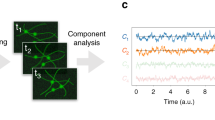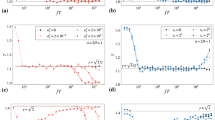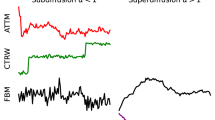Abstract
Diffusion can be used to infer the microscopic features of a system from the observation of its macroscopic dynamics. Brownian motion accurately describes many diffusive systems, but non-Brownian and nonergodic features are often observed on short timescales. Here, we trap a single ultracold caesium atom in a periodic potential and measure its diffusion1,2,3. We engineer the particle–environment interaction to fully control motion over a broad range of diffusion constants and timescales. We use a powerful stroboscopic imaging method to detect single-particle trajectories and analyse both non-equilibrium diffusion properties and the approach to ergodicity4. Whereas the variance and two-time correlation function exhibit apparent Brownian motion at all times, higher-order correlations reveal strong non-Brownian behaviour. We additionally observe the slow convergence of the exponential displacement distribution to a Gaussian and—unexpectedly—a much slower approach to ergodicity5, in perfect agreement with an analytical continuous-time random-walk model6,7,8. Our experimental system offers an ideal testbed for the detailed investigation of complex diffusion processes.
This is a preview of subscription content, access via your institution
Access options
Subscribe to this journal
Receive 12 print issues and online access
$259.00 per year
only $21.58 per issue
Buy this article
- Purchase on SpringerLink
- Instant access to full article PDF
Prices may be subject to local taxes which are calculated during checkout




Similar content being viewed by others
References
Risken, H. The Fokker–Planck Equation (Springer, 1989).
Fulde, P., Pietronero, L., Schneider, W. R. & Strässler, S. Problem of Brownian motion in a periodic potential. Phys. Rev. Lett. 35, 1776–1779 (1975).
Barone, A. & Paterno, G. Physics and Applications of the Josephson Effect (Wiley, 1982).
Dorfman, J. R. An Introduction to Chaos in Nonequilibrium Statistical Mechanics (Cambridge Univ. Press, 1999).
Lutz, E. & Renzoni, F. Beyond Boltzmann–Gibbs statistical mechanics in optical lattices. Nat. Phys. 9, 615–619 (2013).
Montroll, E. W. & Weiss, G. H. Random walks on lattices. II. J. Math. Phys. 6, 167–181 (1965).
Klafter, J. & Sokolov, I. M. First Steps in Random Walks (Oxford Univ. Press, 2011).
Scher, H. & Lax, M. Stochastic transport in a disordered solid I. Theory. Phys. Rev. B 7, 4491–4502 (1973).
Frey, E. & Kroy, K. Brownian motion: a paradigm of soft matter and biological physics. Ann. Phys. 14, 20–50 (2005).
Kramers, H. A. Brownian motion in a field of force and the diffusion model of chemical reactions. Physica 7, 284–304 (1940).
Wang, B., Anthony, S. M., Bae, S. C. & Granick, S. Anomalous yet Brownian. Proc. Natl Acad. Sci. USA 106, 15160–15164 (2009).
Li, T., Kheifets, S., Medellin, D. & Raizen, M. G. Measurement of the instantaneous velocity of a Brownian particle. Science 328, 1673–1675 (2010).
Han, Y. et al. Brownian motion of an ellipsoid. Science 314, 626–630 (2006).
Fakhri, N., MacKintosh, F. C., Lounis, B., Cognet, L. & Pasquali, M. Brownian motion of stiff filaments in a crowded environment. Science 330, 1804–1807 (2010).
D’Anna, G., Mayor, P., Barrat, A., Loreto, V. & Nori, F. Observing Brownian motion in vibration-fluidized granular matter. Nature 424, 909–912 (2003).
La Porta, A., Voth, G. A., Crawford, A. M., Alexander, J. & Bodenschatz, E. Fluid particle accelerations in fully developed turbulence. Nature 409, 1017–1019 (2001).
Wang, B., Kuo, J., Bae, S. C. & Granick, S. When Brownian diffusion is not Gaussian. Nat. Mater. 11, 481–485 (2012).
Brokmann, X. et al. Statistical aging and non ergodicity in the fluorescence of single nanocrystals. Phys. Rev. Lett. 90, 120601 (2003).
Jeon, J. H. et al. In vivo anomalous diffusion and weak ergodicity breaking of lipid granules. Phys. Rev. Lett. 106, 048103 (2011).
He, Y., Burov, S., Metzler, R. & Barkai, E. Random time-scale invariant diffusion and transport coefficients,. Phys. Rev. Lett. 101, 058101 (2008).
Manzo, C. et al. Weak ergodicity breaking of receptor motion in living cells stemming from random diffusivity. Phys. Rev. X 5, 011021 (2015).
Lutz, E. Power-law tail distributions and nonergodicity. Phys. Rev. Lett. 93, 190602 (2004).
Viterbi, A. J. & Omura, J. K. Principles of Digital Communication and Coding (Dover, 2013).
Sancho, J. M., Lacasta, A. M., Lindenberg, K., Sokolov, I. M. & Romero, A. H. Diffusion on a solid surface: anomalous is normal. Phys. Rev. Lett. 92, 250601 (2004).
Sagi, Y., Brook, M., Almog, I. & Davidson, N. Observation of anomalous diffusion and fractional self-similarity in one dimension. Phys. Rev. Lett. 108, 093002 (2012).
Douglas, P., Bergamini, S. & Renzoni, F. Tunable Tsallis distributions in dissipative optical lattices. Phys. Rev. Lett. 96, 110601 (2006).
Katori, H., Schlipf, S. & Walther, H. Anomalous dynamics of a single ion in an optical lattice. Phys. Rev. Lett. 79, 2221–2224 (1997).
Burov, S., Jeon, J.-H., Metzler, R. & Barkai, E. Single particle tracking in systems showing anomalous diffusion: the role of weak ergodicity breaking. Phys. Chem. Chem. Phys. 13, 1800–1812 (2011).
Metcalf, H. J. & van der Straten, P. Laser Cooling and Trapping (Springer, 2002).
Risken, H. & Vollmer, H. D. Correlation functions for the diffusive motion of particles in a periodic potential. Z. Phys. B 31, 209–216 (1978).
Deng, W. & Barkai, E. Ergodic properties of fractional Brownian–Langevin motion. Phys. Rev. E 79, 011112 (2009).
Dechant, A., Lutz, E., Kessler, D. A. & Barkai, E. Fluctuations of time averages for Langevin dynamics in a binding force field. Phys. Rev. Lett. 107, 240603 (2011).
Hohmann, M. et al. Neutral impurities in a Bose–Einstein condensate for simulation of the Fröhlich-polaron. EPJ Quantum Technol. 2, 1–15 (2015).
Acknowledgements
This work was partially funded by the ERC Starting Grant No. 278208, the Collaborative Project TherMiQ (Grant Agreement 618074) and the SFB/TRR49. T.L. acknowledges funding by Carl Zeiss Stiftung. D.M. is a recipient of a DFG-fellowship through the Excellence Initiative by the Graduate School Materials Science in Mainz (GSC 266). F.S. acknowledges funding by the Studienstiftung des deutschen Volkes.
Author information
Authors and Affiliations
Contributions
A.W. and F.K. conceived the experiment. F.K., M.H., T.L., D.M. and F.S. took experimental data, F.K. analysed the data. A.D. and E.L. developed the theoretical model and performed numerical simulations. All authors contributed in interpretation, discussion and writing of the manuscript.
Corresponding author
Ethics declarations
Competing interests
The authors declare no competing financial interests.
Supplementary information
Supplementary information
Supplementary information (PDF 252 kb)
Rights and permissions
About this article
Cite this article
Kindermann, F., Dechant, A., Hohmann, M. et al. Nonergodic diffusion of single atoms in a periodic potential. Nature Phys 13, 137–141 (2017). https://doi.org/10.1038/nphys3911
Received:
Accepted:
Published:
Issue date:
DOI: https://doi.org/10.1038/nphys3911
This article is cited by
-
Reliable deep learning in anomalous diffusion against out-of-distribution dynamics
Nature Computational Science (2024)
-
Topology mediates transport of nanoparticles in macromolecular networks
Nature Communications (2022)
-
Bayesian deep learning for error estimation in the analysis of anomalous diffusion
Nature Communications (2022)
-
Tunable anomalous transports by Friction and Noise
Indian Journal of Physics (2022)
-
Objective comparison of methods to decode anomalous diffusion
Nature Communications (2021)



